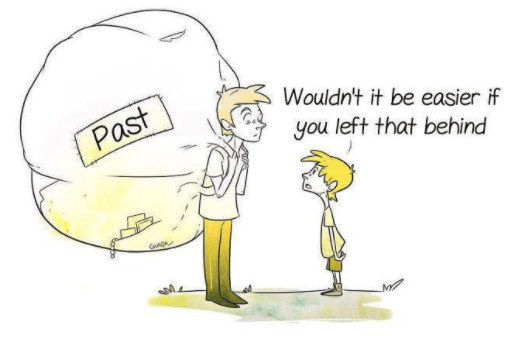- Winning With Words
- Posts
- Let Go or Be Dragged
Let Go or Be Dragged
What the tale of two monks can teach us about letting go of the past and what no longer serves us.

The Tale of Two Monks
In the Spring of 2021, I started to utilize more storytelling to share core principles related to mental performance with professional baseball players. One of my favorite moments came one morning when one of them flipped the script and shared the following Zen parable with me:
A senior monk and a junior monk were traveling together when they arrived at a river with a strong current. A young woman stood at the edge, hesitant to cross. She asked the monks for help, but they had taken vows not to touch a woman. Without hesitation, the older monk picked her up, carried her across, and set her down on the other side before continuing on his journey.
The younger monk was shocked and speechless as he watched this interaction. About an hour passed and he found himself unable to shake what had happened. Finally, he blurted out, “Brother, as monks, we are not permitted to touch a woman. Why did you carry that woman across the river?” The elder monk simply replied, “Brother, I set her down on the other side of the river an hour ago. Why are you still carrying her?”
This story presents a powerful reminder: It’s often not a past event that weighs us down, but our inability to let it go.
Let Go or Be Dragged
There might not be a more popular mental game buzzphrase than “Control what you can control,” but people often forget the second part of this phrase. It’s “Control what you can control…AND let go of the things you can’t control.”
Christian McCaffrey on mentality, being present, and the skill of letting go.
#MVPMind
— Zach Brandon (@MVP_Mindset)
3:39 PM • Dec 12, 2023
When we obsess over what we can’t control, we run the risk of being dragged by what no longer serves. The best performers are relentlessly disciplined to what they can control (e.g. the present), while simultaneously being skilled at surrendering what they can’t control (e.g. the past).
Think of it like driving a car: Imagine if you attempted to drive forward by staring at the rearview mirror. This approach will guarantee that you will crash. The past is like that rearview mirror where we can use it briefly to learn from what we’ve already experienced, but if we fixate on it, then we’ll miss what’s right in front of us.
When athletes dwell on the past, they carry unnecessary weight. That mental baggage drains energy, disrupts focus, and erodes confidence. Carrying mistakes and failures is akin to playing with a backpack full of bricks. Each time you practice letting go you’re slowly releasing one of those bricks so you can play “light and free.”
As the old Zen proverb states: “Let go or be dragged.”
3 Strategies for Helping Athletes “Let Go”
1. Use a Release Ritual – Encourage athletes to create a simple physical action to symbolize letting go. This could be a deep breath, wiping their hand on their belt, or grabbing a blade of grass and throwing it to symbolize the release.
Two-time Most Valuable Player, Aaron Judge, read the classic mental game book “Heads Up Baseball” (authored by sport psychology legend, Dr. Ken Ravizza) and developed his own release ritual (see below).
Aaron Judge on mental skills.
Great example of a physical reset to slow things down and focus on the next pitch.
#MVPMind
— Zach Brandon (@MVP_Mindset)
4:33 PM • Oct 14, 2022
Bonus tool – Perhaps the most underrated mental game “tool” is the postgame shower. The shower is a great way to wash away any thoughts and emotions and symbolically let go of the performance.
2. Reframe the Mistake – Letting go isn’t just about physically releasing a mistake, but it’s also about changing our relationship to our thoughts about the mistake. We can’t always control the content of our thoughts, but we do have a choice in how we view them. Below are examples of how you might help an athlete reframe events to move on and move forward.
Situation: Missed a game-winning shot
Reframe: “Now I know what pressure feels like and I’m more prepared to manage it next time.”
Situation: Coach called me out in front of everyone
Reframe: “Coach believes I’m capable of more than I’m showing.”
Perhaps the greatest reframe quote of all-time belongs to Michael Jordan: “I've missed more than 9,000 shots in my career. I've lost almost 300 games. Twenty-six times I've been trusted to take the game-winning shot and missed. I've failed over and over and over again in my life. And that is why I succeed.”
3. Create a New Target – The mind works optimally when it has something particular to focus on. When mistakes or failures arise, some athletes resort to avoidance and try to simply block it out of their memories. Unfortunately, this approach works terribly. Just use the classic “Don’t think of a pink elephant” line and we can see how poorly avoidance works.
Instead, help athletes let go by directing their focus to their next target (e.g. the next pitch/play/game/etc.). Focus isn’t about ignoring anything, but rather becoming so locked in on one thing that nothing else matters.
Bottom line: Until you commit your focus to something, you’ll be distracted by everything.
Final Thoughts
Freedom awaits when one lets go of the past and chooses to not let their history control their destiny.